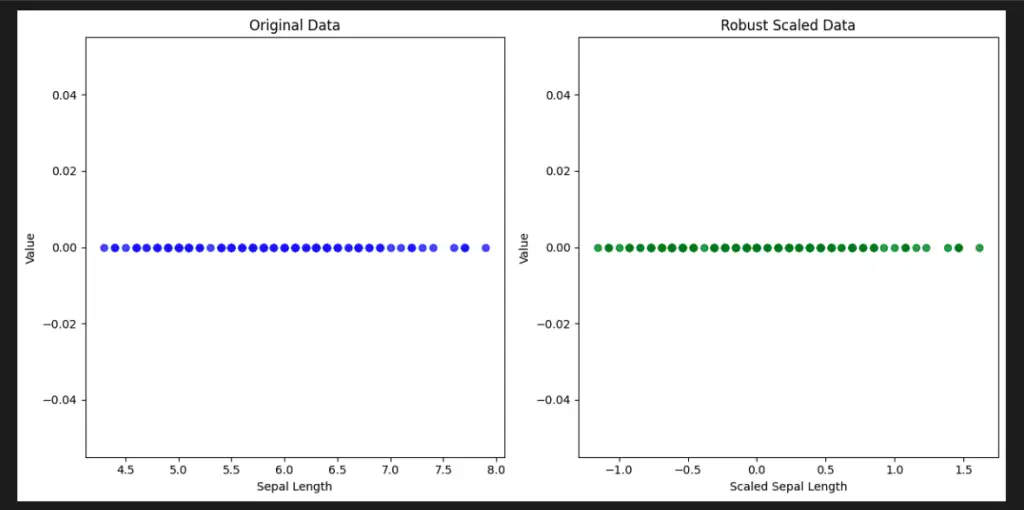RobustScaler is a valuable data preprocessing technique in the Scikit-Learn library that enables robust feature scaling.

What is Robust Scaling?
Robust scaling is a data preprocessing method that minimizes the impact of outliers while scaling features.
Understanding RobustScaler
RobustScaler is a class in Scikit-Learn that scales features by removing the median and scaling data to the interquartile range.
Key Features and Parameters
- Quantile Range: Determines the range of quantiles used for scaling.
- Centering: Specifies whether to center the data before scaling.
- Scaling: Specifies whether to scale the data.
Benefits of Using RobustScaler
- Outlier Insensitivity: RobustScaler is less affected by outliers compared to standard scaling.
- Improved Model Performance: Scaling features can enhance model convergence and performance.
- Feature Transformation: RobustScaler transforms data while preserving data distribution.
Applying RobustScaler
- Import the module: Import RobustScaler from sklearn.preprocessing.
- Prepare your data: Ensure your dataset is ready for scaling.
- Instantiate RobustScaler: Create an instance of RobustScaler.
- Fit and Transform: Apply the scaler to your data using fit_transform.
- Proceed with Modeling: Utilize scaled data for training and evaluating machine learning models.
Considerations and Limitations
- Parameter Tuning: Experiment with quantile range for desired scaling behavior.
- Data Characteristics: Understand how RobustScaler affects different types of data.
- Impact on Interpretability: Scaled data might require careful interpretation.
Python Code Examples
RobustScaler Example
import numpy as np
from sklearn.preprocessing import RobustScaler
# Sample data with outliers
data = np.array([[1.0], [2.0], [3.0], [100.0]])
# Instantiate RobustScaler
scaler = RobustScaler()
# Apply robust scaling
scaled_data = scaler.fit_transform(data)
print(f'Data:\n {data}\n')
print(f'Scaled Data:\n {scaled_data}\n')

Visualize Scikit-Learn Preprocessing RobustScaler with Python
Let’s visualize the effects of RobustScaler from Scikit-Learn’s preprocessing module on a built-in dataset using the Matplotlib library.
import numpy as np
import matplotlib.pyplot as plt
from sklearn.datasets import load_iris
from sklearn.preprocessing import RobustScaler
# Load the Iris dataset
data = load_iris()
X = data.data[:, 0].reshape(-1, 1) # Select sepal length feature
# Apply RobustScaler
scaler = RobustScaler()
scaled_data = scaler.fit_transform(X)
# Create subplots
fig, axes = plt.subplots(1, 2, figsize=(12, 6))
# Plot original data
axes[0].scatter(X, np.zeros_like(X), color='blue', alpha=0.7)
axes[0].set_title('Original Data')
axes[0].set_xlabel('Sepal Length')
axes[0].set_ylabel('Value')
# Plot scaled data
axes[1].scatter(scaled_data, np.zeros_like(scaled_data), color='green', alpha=0.7)
axes[1].set_title('Robust Scaled Data')
axes[1].set_xlabel('Scaled Sepal Length')
axes[1].set_ylabel('Value')
plt.tight_layout()
plt.show()
In this example, we use the Iris dataset and focus on the sepal length feature. We apply RobustScaler and visualize the original and scaled data distributions side by side using scatter plots. This visualization helps us observe how robust scaling impacts the distribution and range of the data, especially in the presence of outliers.

Important Concepts in Scikit-Learn Preprocessing RobustScaler
- Data Scaling Techniques
- Outlier Handling
- Feature Transformation
- Scaling Sensitivity
- Quantiles and Percentiles
- Impact on Model Performance
- Parameter Tuning
- Robust Statistics
To Know Before You Learn Scikit-Learn Preprocessing RobustScaler?
- Basic understanding of machine learning concepts and terminology.
- Familiarity with Python programming language and its syntax.
- Knowledge of data preprocessing techniques.
- Understanding of feature scaling and its importance.
- Awareness of outliers and their impact on data analysis.
- Familiarity with Scikit-Learn library and its preprocessing module.
- Basic grasp of statistical concepts such as quantiles and percentiles.
- Experience with data visualization and exploratory data analysis.
What’s Next?
- Feature Engineering: Techniques to create new features for enhanced model performance.
- Standard Scaling: Exploring standard scaling for comparison with robust scaling.
- Feature Selection: Methods to choose relevant features and reduce dimensionality.
- Other Scaling Techniques: Investigating additional scaling methods like min-max scaling.
- Data Imputation: Handling missing values in datasets using various strategies.
- Advanced Machine Learning Algorithms: Applying scaled data to various algorithms for predictive modeling.
Relevant Entities
| Entities | Properties |
|---|---|
| RobustScaler | Scikit-Learn class for robust feature scaling |
| Data Preprocessing | Techniques to prepare data for machine learning |
| Feature Scaling | Process of transforming feature values for modeling |
| Outliers | Extreme data points affecting analysis |
| Quantile Range | Range of quantiles used for scaling |
| Model Performance | Evaluation of model’s predictive ability |
| Parameter Tuning | Adjusting parameters for desired behavior |
| Machine Learning Workflow | Sequence of tasks in machine learning |
The primary entity in the context of Scikit-Learn Preprocessing RobustScaler is the RobustScaler class itself. It enables robust feature scaling, a crucial step in data preparation.
Sources
Here are some of the most popular pages related to the topic of Scikit-Learn Preprocessing RobustScaler in machine learning:
- scikit-learn.org/stable/modules/generated/sklearn.preprocessing.RobustScaler.html">Scikit-Learn Documentation: The official documentation provides detailed information about the RobustScaler class and its usage.
- scikit-learn.org/stable/auto_examples/preprocessing/plot_all_scaling.html#sphx-glr-auto-examples-preprocessing-plot-all-scaling-py">Scikit-Learn Scaling Examples: Explore Scikit-Learn’s official examples showcasing various scaling techniques, including RobustScaler.
Conclusion
Scikit-Learn Preprocessing RobustScaler is a versatile tool for preparing data with outliers. By applying robust scaling, you can enhance the suitability of your data for various machine learning algorithms and achieve more reliable results.

